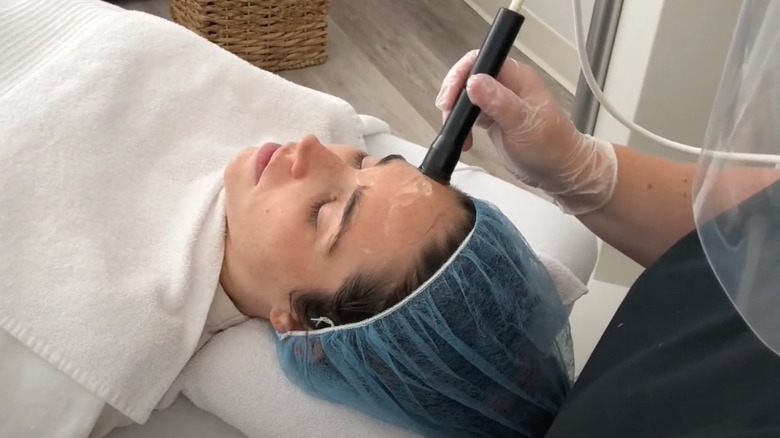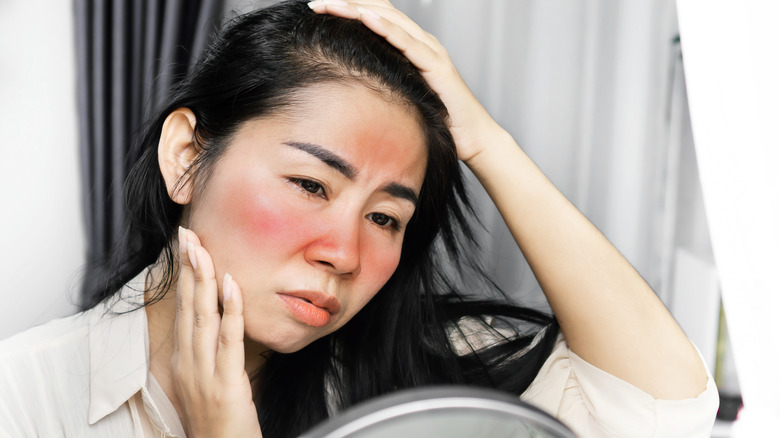Trendy Skincare Treatment Alert: What To Know About Cold Lasers
Traditionally, laser skin resurfacing — known as lasabrasion treatments or laser peels, such as Fraxel — is conducted using heat-based lasers that essentially burn away the outermost layer of one's skin. As explained by the Cleveland Clinic, this allows for the removal of lesions and a reduction in the appearance of wrinkles, scars, and hyperpigmentation. The tissue beneath the removed layer of skin is also heated with the goal of stimulating collagen production and regenerating a new layer of firmer and smoother skin. Though there's nothing wrong with skin of any age, many people who undergo these treatments do so in hopes of having younger-looking skin.
Unfortunately, not everyone is a safe candidate for heat-based laser treatments. People with darker skin tones are often unable to access these treatments due to the fact that heat-based lasers can lead to the development of hyperpigmentation — a skin condition the treatment is supposed to fix — in their skin during the recovery period (via the Cleveland Clinic). Finally, however, a safer option has hit the skincare market: cold laser treatments. If you've been turned off by laser resurfacing in the past, it may be time to take another look — and no need to worry if you don't like the cold, as Healthline notes that cold lasers are only named so in opposition to traditional heat-based treatments. In this case, the lasers' lights are gentler, so they don't create enough heat to actually warm your skin.
Advantages of cold laser treatments
Cold laser skin resurfacing, also called low-level laser light therapy (LLLT), utilizes the titular low-level lasers that are, as the name implies, not heat-based. "The advantage of not being heat-based is that they minimize unwanted thermal damage," Dr. Hadley King, a board-certified dermatologist specializing in medical and cosmetic dermatology, exclusively tells Glam. "This makes them less painful, it makes the downtime shorter, and it makes them safer for more melanin-rich skin types and for those with a tendency toward melasma." The largest company backing this science and producing this equipment is UltraClear, with the skincare solution brand offering practitioners several levels of treatment intensity for their clients' varying schedules and needs.
The purpose of the cold-laser treatment is to remove one's surface layer of skin and stimulate the same collagen production and regeneration of new skin that a heat-based treatment produces (via the Cleveland Clinic). However, a low-energy cold laser won't penetrate as deeply into the tissue beneath the skin as a heat-based laser will. This results in a treatment that's less painful, safer for dark skin tones, and easier to recover from, but it may require multiple sessions, depending on your goals and the current condition of your skin (via Healthline).
What's more, cold lasers are inherently less invasive, and this procedure may actually "stimulate healing" thanks to the laser's interaction with your cells, according to a 2020 study published in the Journal of Chiropractic Medicine. While this study was primarily focused on LLLT's interaction with muscles, its findings regarding cells could prove hopeful and useful for skincare treatments, too.
What to expect from a cold laser treatment
After a traditional heat-based laser treatment, patients can expect to experience discomfort, swelling, redness, blistering, oozing, and crusting for roughly a week before their skin peels away and reveals a fresh, new layer. Their skin will remain pink/red and more sensitive to sun exposure for up to 12 months, according to the American Society of Plastic Surgeons.
Cold-laser treatments may require a less intense recovery period — or no recovery period if you choose a more surface-level treatment — but resurfacing treatments are not without downtime. On these varying treatments, Dr. Hadley King exclusively tells Glam, "Different settings can be used for a more superficial treatment vs. a deeper treatment, so be sure to discuss your skin goals before the treatment." In addition to your skin goals, if you know you won't have a lot of healing time, consider opting for the lightest treatment option your clinic offers.
As cautioned by Krauss Dermatology, if you opt for a full skin resurfacing, you can still expect to experience redness or swelling and peeling a few days after the procedure, as well as fresh, delicate skin that requires extra care and sun protection for the next month. However, you'll be less likely to wrestle with blistering, hyperpigmentation, or melasma as a result of your treatment when compared to heat-based laser treatment (via Aboutanos Plastic Surgery).

